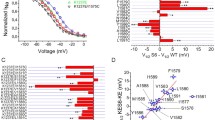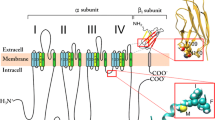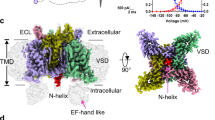Abstract
Elementary Na+ currents were recorded in inside-out patches from neonatal rat heart cardiocytes to analyze the influence of a site-directed polyclonal anti-serum against the linker region between the domains III and IV (amino acids 1489–1507 of the cardiac Na+ channel protein) on Na+ channel gating and to test whether this part of the α-subunit may be considered as a target for modifying agents such as the (−)-enantiomer of DPI 201-106.
Anti-SLP 1 serum (directed against amino acids 1490–1507) evoked, usually within 10–15 min after cytosolic administration, modified Na+ channel activity. Antiserum-modified Na+ channels retain a single open state but leave, at −60 mV for example, their conducting configuration consistently with an about threefold lower rate than normal Na+ channels. Another outstanding property of noninactivating Na+ channels, enhanced burst activity, may be quite individually pronounced, a surprising result which is difficult to interpret in terms of structure function relations. Removal of inactivation led to an increase of reconstructed peak I Na (indicating a rise in NP o) and changed I Na decay to obey second-order kinetics, i.e., open probability declined slowly but progressively during membrane depolarization. The underlying deactivation process is voltage dependent and responds to a positive voltage shift with a deceleration but may operate even at the same membrane potential with different rates. Iodatemodified Na+ channels exhibit very similar properties including a conserved conductance. They are likewise controlled by an efficient, voltage-dependent deactivation process. Modification by (−)-DPI 201-106 fundamentally contrasts to the influence of anti-SLP 1 serum and the protein reagent iodate since (−)-DPI-modified Na+ channels maintain their open probability for at least 120 msec, i.e., a deactivation process seems lacking. This functional difference suggests that the linker region between the domains III and IV of the α-subunit may not be the only target for (−)-DPI 201-106 and related compounds, if at all.
Similar content being viewed by others
References
Aldrich, R.W., Corey, D.P., Stevens, D.F. 1983. A reinterpretation of mammalian sodium channel gating based on single channel recording. Nature 306:436–441
Barnes, S., Hille, B. 1988. Veratridine modifies open sodium channels. J. Gen. Physiol. 91:421–443
Böltz, T., Hummel, R.P., Tröger, W., Rübsamen-Waigmann, H., Biesert, L., Müller-Lantzsch, N., Koch, P., Bessler, W., Jung, G. 1988. Distinction between HIV-1 and HIV-2 infection using novel synthetic lipopeptide conjugates as antigens in enzyme immunoassays. J. Virol. Meth. 22:173–182
Brown, A.M., Less, K.S., Powell, T. 1981. Sodium currents in single rat heart cells. J. Physiol. 318:479–500
Catterall, W.A. 1988. Structure and function of voltage-sensitive ion channels. Science 242:50–61
Chinn, K., Narahashi, T. 1986. Stabilization of sodium channel states by deltamethrin in mouse neuroblastoma cells. J. Physiol. 380:191–207
Colquhoun, D., Sigworth, F.J. 1983. Fitting and statistical analysis of single channel records. In: Single Channel Recordings. B. Sakmann and E. Neher, editors, pp. 191–264. Plenum, New York
Gordon, D., Merrick, D., Wollner, D.A., Catterall, W.A. 1988. Biochemical properties of sodium channels in a wide range of excitable tissues studied with site-directed antibodies. Biochemistry 27:7032–7038
Gorin, G., Godwin, W.E. 1966. The reaction of iodate with cysteine and with insulin. Biochem. Biophys. Res. Comm. 25:227–232
Guy, H.R., Seetharamulu, P. 1986. Molecular model of the action potential sodium channel. Proc. Natl. Acad. Sci. USA 83:508–512
Hamill, O.P., Marty, A., Neher, E., Sakmann, B., Sigworth, F.J. 1981. Improved patch-clamp techniques for high resolution current recordings from cells and cell-free membrane patches. Pfluegers Arch. 391:85–100
Hille, B. 1984. Ionic Channels in Excitable Membranes. Sinauer Associates, Sunderland, MA
Horn, R., Vandenberg, C.A. 1984. Statistical properties of single sodium channels. J Gen. Physiol. 84:505–534
Isom, L.L., deGongh, K.S., Patton, D.E., Reber, B.F.X., Offord, J., Charbonneau, H., Walch, K., Goldin, A.L., Catterall, W.A. 1992. Primary structure and functional expression of the β 1 subunit of the rat brain sodium channel. Science 256:839–842
Jung, G., Wiesmüller, K.-H., Becker, G., Bühring, H.-J., Bessler, W.G. 1985. Verstärkte Produktion spezifischer Antikörper durch Präsentation der antigenen Determinanten mit kovalent verknüpften Lipopeptid-Mitogenen. Angew. Chem. 97:883–885; Angew. Chem. Int. Ed. Engl. 24:872–873
Keller, B.U., Hartshorne, R.P., Talvenheimo, J.A., Catterall, W.A., Montal, M. 1986. Sodium channels in planar lipid bilayers. Channel gating kinetics of purified sodium channels modified by batrachotoxin. J. Gen. Physiol. 88:1–23
Kohlhardt, M., Fröbe, U., Herzig, J.W. 1986. Modification of single cardiac Na+ channels by DPI 201–106. J. Membrane Biol. 89:163–172
Kohlhardt, M., Fröbe, U., Herzig, J.W. 1987. Properties of normal and non-inactivating single cardiac Na+ channels. Proc. R. Soc. London B 232:71–93
Kohlhardt, M., Fichtner, H., Fröbe, U. 1988. Predominance of poorly reopening single Na+ channels and lack of slow Na+ inactivation in neonatal cardiocytes. J. Membrane Biol. 103:283–291
Kohlhardt, M., Fichtner, H., Fröbe, U. 1989. Gating in iodatemodified single cardiac Na+ channels. J. Membrane Biol. 112:67–78
Lehmann-Horn, F., Iaizzo, P.A., Halt, H., Franke, Ch. 1991. Altered gating and conductance of Na+ channels in hyperkalemic periodic paralysis. Pfluegers Arch. 418:297–299
Metzger, J., Wiesmüller, K.H., Schaude, R., Bessler, W.G., Jung, G. 1991. Synthesis of novel immunological active tripalmitoyl-S-gylcerylcysteinyl lipopeptides as useful intermediates for immunogen preparations. Int. J. Peptide Protein Res. 37:46–57
Metzger, J.W., Beck, W., Jung, G. 1992. Ion-spray mass spectrometry of lipopeptide vaccines. Angew Chem. 104:235–237; Angew Chem. Int. Ed. Engl. 31:226–228
Moorman, J.R., Kirsch, G.E., Brown, A.M., Joho, R.H. 1990. Changes in sodium channel gating produced by point mutations in a cytoplasmic linker. Science 250:688–691
Nagy, K. 1988. Mechanism of inactivation of single sodium channels after modifications by chloramine-T, sea anemona toxin and scorpion toxin. J. Membrane Biol. 106:29–40
Noda, M., Ikeda, T., Kayano, T., Suzuki, H., Takeshima, H., Kurasaki, M., Takahashi, H., Numa, S. 1986. Existence of distinct sodium channel messenger RNAs in rat brain. Nature 320:188–192
Prass, W., Ringsdorf, H., Bessler, W., Wiesmüller, K.H., Jung, G. 1987. Lipopeptides of the N-terminus of Escherichia coli lipoprotein: synthesis, mitogenicity and properties in monolayer experiments. Biochim. Biophys. Acta 900:116–128
Quandt, F.N. 1987. Burst kinetics of sodium channels which lack fast inactivation in mouse neuroblastoma cells. J. Physiol. 392:563–585
Rogart, R.B., Cribbs, L.L., Muglia, L.K., Kephart, D.D., Kaiser, M.W. 1989. Molecular cloning of a putative tetrodotoxin-resistant rat heart Na+ channel isoform. Proc. Natl. Acad. Sci. USA 86:8170–8174
Rojas, C.V., Wang, J., Schwartz, L.S., Hoffman, E.P., Powell, B.R., Brown, R.H. 1991. A met-to-val mutation in the skeletal muscle Na+ channel α-subunit in hyperkalaemic periodic paralysis. Nature 354:387–389
Romey, G., Quast, U., Pauron, D., Frelin, C., Renaud, J.F., Lazdunski, M. 1987. Na+ channels as sites of action of the cardiotonic agent DPI 201–106 with agonist and antagonist enantiomers. Proc. Natl. Acad. Sci. USA 84:896–900
Salgado, V.L., Yen, J.Z., Narahashi, T. 1985. Voltage-dependent removal of sodium inactivation by N-bromoacetamide and pronase. Biophys. J. 47:567–571
Scanley, B.E., Fozzard, H.A. 1987. Low conductance sodium channels in canine cardiac Purkinje cells. Biophys. J. 52:489–495
Scholtysik, G., Quast, U., Schaad, A. 1986. Evidence for different receptor sites for the novel cardiotonic S-DPI 201–106, ATX II and veratridine on the cardiac sodium channel. Eur. J. Pharmacol. 125:111–118
Stühmer, W., Conti, F., Suzuki, H., Wang, X., Noda, M., Yahagi, N., Kubo, H., Numa, S. 1989. Structural parts involved in activation and inactivation of the sodium channel. Nature 339:597–603
Terlau, H., Heinemann, S.H., Stühmer, W., Pusch, M., Conti F., Imoto, K., Numa, S. 1991. Mapping the site of block by tetrodotoxin and saxitoxin of sodium channel II. FEBS Lett. 293:93–96
Vassilev, P.M., Scheuer, T., Catterall, W.A. 1988. Identification of an intracellular peptide segment involved in sodium channel inactivation. Science 241:1658–1661
Vassilev, P.M., Scheuer, T., Catterall, W.A. 1989. Inhibition of inactivation of single sodium channels by a site-directed antibody. Proc. Natl. Acad. Sci. USA 86:8147–8151
Wiesmüller, K.H., Jung, G., Hess, G. 1989. Novel low-molecular-weight synthetic vaccine against foot-and-mouth-disease containing a potent B-cell and macrophage activator. Vaccine 7:29–33
Wiesmüller, K.H., Deres, K., Shi, L., Wei, D., Wernet, P., Jung, G. 1992. Lipopeptide-helper T cell epitope-CTL-epitope conjugate induces monoclonal antibodies against the CTL epitope. In: Innovation and Perspectives in Solid Phase Synthesis and Related Technologies: Peptides, Polypeptides and Oligonucleotides. R. Epton, editor. Intercept, Andover (in press)
Zilberter, Y.I., Motin, L.G. 1991. Existence of two fast inactivation states in cardiac Na+ channels confirmed by two-stage action of proteolytic enzymes. Biochim. Biophys. Acta 1068:77–80
Author information
Authors and Affiliations
Additional information
This work was supported by a grant of the Deutsche Forschungs-gemeinschaft (Ko 778/2–4), Bonn.
Rights and permissions
About this article
Cite this article
Beck, W., Benz, I., Bessler, W. et al. Responsiveness of cardiac Na+ channels to a site-directed antiserum against the cytosolic linker between domains III and IV and their sensitivity to other modifying agents. J. Membarin Biol. 134, 231–239 (1993). https://doi.org/10.1007/BF00234504
Received:
Revised:
Issue Date:
DOI: https://doi.org/10.1007/BF00234504




